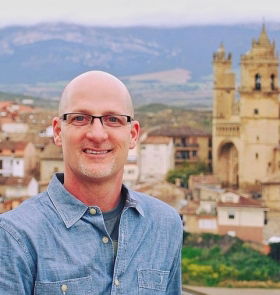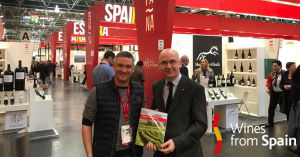BLOG
WSG
Summary:
Steep slopes and vertigo-inducing vineyards make Ribeira Sacra one of Spain's most stunning wine regions. With terraced vineyards that rival the Mosel or Douro, the region is known for its floral, austere expressions of Mencía. We'll take a deep dive into Ribeira Sacra's history and culture, and learn about why this region is producing some of the most exciting wines in Spain today. Following the presentation, a question & answer session will take place,
#thespanishwineguy joins the WSG team full-time
A couple of months ago we introduced you to Rick Fisher, our Program Developer for the upcoming Spanish Wine Scholar® (SWS) program. By way of reminder, Rick is part Catalan with a passion for his heritage and a desire to educate others about Spanish wine and food. In his spare time, he has authored the blog Bodega: Eat. Drink. Explore. ESPAÑA!, whose aim is to further educate readers about the amazing wines and food of Spain.Rick has enjoyed a long career in finance and, over the past few years, found himself drawn to pursuing more credentials within the wine industry (He is currently a WSET Diploma student with Napa Valley Wine Academy). As a result of his passion for Spain and the wine business, he left his finance job last week in order to devote all of his time to the creation of our Spanish Wine Scholar® program, whose expected launch is late-2018.Q1. Rick, you just made a huge personal move, giving up a 20-year career in finance – to work full-time in the wine industry, more specifically to devote all your time to the development of the SWS program. How are you feeling about that decision?
As part of a partnership between Wine Scholar Guild and Decanter, we are pleased to share with our readers this article pulled from Decanter Premium. Try Decanter Premium for 4 weeks for just $1! More information HERE
Robert Parker says a 100-point wine should be ‘as exceptional as a particular wine can be: a perfect blend of power, richness, texture, depth, length, balance, freshness, and of course a reflection of its vintage and terroir or origin’.
Here are Parker’s most memorable 100-point wines.
Wine has been fermented and aged in barrels for centuries. Originally, it was just a convenient material from which to fashion vessels – a bit less cumbersome than clay, and a bit more flexible too. But in the 20th century, the flavour and character of oak became integrable to many popular wine styles, such as the red wines
On June 25th, London played host to a prestigious gathering of Italy's top wine producers, unveiling their flagship wines to the UK trade and press.
The Science of Wine Tasting Course
This multi-part series is designed for food and wine professionals, wine judges, wine educators, wine and food journalists, wine students and anyone who relies on their senses to assess, evaluate, critique and/or write about wine and food.
There are four parts to this series, each with three sessions.
Part One: Neuroscience of Wine Tasting with Gabriel Lepousez
Science of Wine Tasting Course
This multi-part series is designed for food and wine professionals, wine judges, wine educators, wine and food journalists, wine students and anyone who relies on their senses to assess, evaluate, critique and/or write about wine and food.
There are four parts to this series, each with three sessions.
Science of Wine Tasting Course
This multi-part series is designed for food and wine professionals, wine judges, wine educators, wine and food journalists, wine students and anyone who relies on their senses to assess, evaluate, critique and/or write about wine and food.
Science of Wine Tasting Course
This multi-part series is designed for food and wine professionals, wine judges, wine educators, wine and food journalists, wine students and anyone who relies on their senses to assess, evaluate, critique and/or write about wine and food.
Summary:
Welcome to the soil signatures course! This course is aimed at helping students understand the very tangible effect that different soil types can have on the flavours we encounter in the glass.
Summary:
Welcome to the soil signatures course! This course is aimed at helping students understand the very tangible effect that different soil types can have on the flavours we encounter in the glass.
Introduction
As a wine lover, chances are great that you also enjoy eating well. Both wine and food individually hold the power to unlock the best potential of the other element.
Join us as we explore the theory and application behind
Introduction
As a wine lover, chances are great that you also enjoy eating well. Both wine and food individually hold the power to unlock the best potential of the other element.
Join us as we explore the theory and
Spanish Wine Scholar® launches in October 2019 and we are excited to announce the program has been endorsed by Wines from Spain, the public face of ICEX Spain Trade & Investment government agency.
Earlier this year, I embarked on the French Wine Scholar (FWS) program; version 7 being the latest update to this ever-popular certification offered by Wine Scholar Guild to wine enthusiasts and professionals alike. Here are my top study tips for passing the French Wine Scholar program!
Summary:
From their genesis in the late 1960s to their most modern iterations, Super Tuscans have enjoyed an uninterrupted reign on the international scene. Initially, production style trumped terroir, but now, thanks to viticultural improvements combined with the effects of climate change, we see the evolution of one winemaker’s initial hunch into a family of world-class wines. Characterised by their Bordeaux influences and divergence from traditional Italian
Summary:
Today we get behind the scenes at the Decanter World Wine Awards. Over the last 21 years the DWWA has grown to become the world's largest and most influential wine competition. The 2024 contest was held in London in May, where 235 region-specific panels meticulously assessed a staggering 18,143 wines from every region across the globe. In this special event we are delighted to be
The 2022 vintage was, in general, a great year for France. Weirdly. Look at the data. It shouldn’t have been: the gauges for both drought and heat were often flashing red. What happened?
Summary:
Marc-André explores the factors that really contribute to what we call 'terroir', including the soil, the climate and the microbiology at play.
In this enlightening webinar he will bust myths and explain the science that truly contributes to the wine that we taste.
About Marc-André Selosse:
Marc-André is a French biologist specializing in botany and mycology. He has worked on symbiosis, particularly in the areas of evolution
Summary:
The Châtillonnais is a small, lesser known wine region, located at the most northern end of the ‘département’ of the Côte d’Or and just south of the Côte des Bar, the most southern section of Champagne.
Due to its proximity to Champagne and its isolation from other Burgundian regions, its history and wine styles are far more linked to its more northerly neighbor. This is a region where its




















